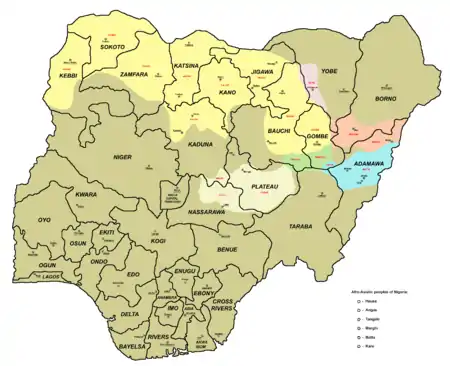Ron languages
The Ron, Ronic or Ron–Fyer languages, group A.4 of the West Chadic branch of the Afro-Asiatic language family, are spoken in Plateau State, north-central Nigeria.
| Ron | |
|---|---|
| Ron–Fyer | |
| Geographic distribution | Mangu LGA, Plateau State, Nigeria |
| Linguistic classification | Afro-Asiatic |
| Subdivisions |
|
| Glottolog | west2716 |
 West Chadic per Newman (1977) | |

The Ron languages have undergone extensive influence from Tarok.[1]
Languages
The Ron languages, and their tentative relatioships, are:[2][3]
- Ron
- Fyer, Tambas
- (branch)
- Central Ron
- Daffo-Mbar-Butura
- Bokkos
- Monguna (Shagawu) [perhaps actually closer to Sha]
- Sha
- Mangar
- Mundat–Karfa
- Kulere (Richa)
- Central Ron
Blench (2019)[4] groups the following in the (Central) Ron/Run dialect cluster: Bokkos, Mbar, Daffo–Butura, Manguna, Mangar, Sha.
While noting that Ron is in fact a complex linkage, Blench (2003) rejects two of the connections proposed in Seibert (1998) [Sha with Mundat–Karfa and Mangar with Kulere/Richa]:[5]
Names and locations
Below is a comprehensive list of Ron language names, populations, and locations from Blench (2019).[4]
| Language | Cluster | Dialects | Alternate spellings | Own name for language | Other names (based on location) | Other names for language | Exonym(s) | Speakers | Location(s) | ||
|---|---|---|---|---|---|---|---|---|---|---|---|
| Fyer | Fier | 1,500 (1970); 10,000 (Blench 1999) | Plateau State, Mangu LGA | ||||||||
| Karfa | Kerifa | 800 (SIL 1973) | Nasarawa State, Akwanga LGA | ||||||||
| Kulere | Tof, Richa, Kamwai: the latter includes Marahai (Marhai) | Akande (Kamwaĩ, Àkàndí (Tof), Kande (Richa) | Tof, Richa, Kamwai | Korom Ɓoye | 6,500 (1925 Meek); 4,933 (1943 Ames); 8,000 (1973 SIL) | Plateau State, Bokkos LGA | |||||
| Mundat | Plateau State, Mangu LGA | ||||||||||
| Shagawu | Shagau | Nafunfia, Maleni | 20,000 (SIL) | Plateau State, Mangu LGA | |||||||
| Tambas | Tembis | 3,000 (SIL) | Plateau State, Mangu LGA | ||||||||
| Run cluster | Run | Bokkos and Daffo–Mbar-Butura are more closely related than Sha | Ron | Run | Challa, Cala, Chala, Challawa | 13,120 (1934 Ames); 60,000 (1985 UBS) | Plateau State, Bokkos LGA | ||||
| Run Bokkos | Run | Bokkos, Baron | Lis ma Run | Bokos | Challa, Cala | ||||||
| Run Daffo–Mbar-Butura | Run | Daffa, Mbar, Butura | Ron | Alis I Run | Batura | Mbar-wuh | Challa | ||||
| Manguna | Run | Plateau State, Mangu LGA | |||||||||
| Mangar | Run | Plateau State, Mangu LGA | |||||||||
| Sha | Run | 500 (SIL); about 1,000 (1970 Jungraithmayr) | Plateau State, Mangu LGA |
Reconstruction
| Proto-Ron | |
|---|---|
| Reconstruction of | Ron languages |
Since the Ron languages form a diverse linkage, Ron reconstruction is not straightforward due to the lack of neat sound correspondences. There are many borrowings from neighbouring Niger-Congo Plateau languages that Ron had assimilated or been in contact with.[3]
Proto-Ron reconstructions by Roger Blench are as follows.[2]
| No. | English | Proto-Ron |
|---|---|---|
| 1. | person | *naaf |
| 7. | friend | **mwin |
| 19. | name | *sum |
| 45. | flesh | *lo |
| 46. | head | *hay |
| 49. | bone | *kaʃ |
| 53. | ear | *kumu |
| 54. | nose | **atin |
| 57. | mouth | *fo |
| 59. | tongue | *liʃ |
| 61. | tooth | *haŋgor |
| 62. | molar | *ɓukum |
| 64. | chin | *njumut |
| 69. | throat | *goroŋ |
| 72. | breast (female) | *fofo |
| 73. | chest | *cin |
| 79. | navel | **mutuk |
| 83. | elbow | *kukwat |
| 91. | thigh | *for |
| 107. | saliva, spittle | *lyal |
| 110. | urine | *sar |
| 190. | I | *yin |
| 238. | crocodile | **haram |
| 1072. | blow (mouth) | *fuɗ |
| 1089. | call (summon) | *lahyal |
| 1157. | fall | *fur |
| 1218. | land | **nɗoro |
| 1241. | meet | *tof |
| 1249. | open (door) | *ɓwali |
| 1276. | put | *kin |
References
- Longtau, Selbut (25–26 March 2004). Some Historical Inferences from Lexical Borrowings and Traditions of Origins in the Tarokoid/Chadic Interface. International Symposium on Endangered Languages in Contact: Nigeria’s Plateau Languages. Hamburg: Asien-Afrika-Institut, Universität Hamburg.
- Blench, Roger. Comparative Ron wordlist.
- Blench, Roger M. 2003. Why reconstructing comparative Ron is so problematic. In Wolff, Ekkehard (ed.), Topics in Chadic linguistics: papers from the 1st biennial international colloquium on the Chadic language family (Leipzig, July 5–8, 2001), 21-42. Köln: Rüdiger Köppe Verlag.
- Blench, Roger (2019). An Atlas of Nigerian Languages (4th ed.). Cambridge: Kay Williamson Educational Foundation.
- Seibert, Uwe. 1998. Das Ron von Daffo (Jos-Plateau, Zentralnigeria): morphologische, syntaktische und textlinguistische Strukturen einer westtschadischen Sprache. (Europäische Hochschulschriften: Reihe XXVII: Asiatische und Afrikanische Studien, 66.) Frankfurt am Main: Peter Lang
![]() This article incorporates text available under the CC BY 3.0 license.
This article incorporates text available under the CC BY 3.0 license.